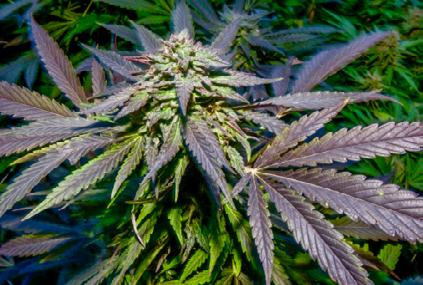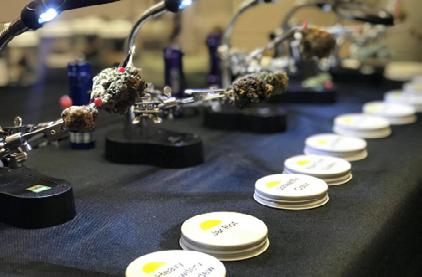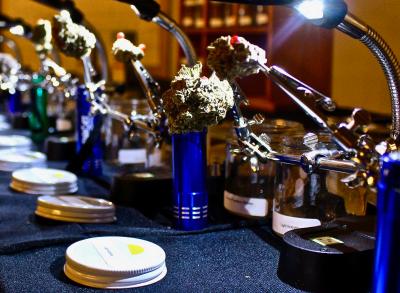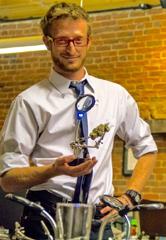
10 minute read
Interpening - Cannabis Sommelier Expertise from USA
Artikel auf Deutsch: www.hanf-magazin.com/dn6
von David Neunhäuserer
Interview with Max Montrose from Trichome Institute
Cannabis use for recreational purposes was pushed into the underground by prohibition but has become continuously more accepted by the general public through gradual legalization in recent years. It can be said that the intoxicating substance is moving ever more from the back rooms and cellars into the center of western society. In the tolerant states of the USA, it has there fore become as normal as opening a bottle of wine or a can of beer to consume potent cannabis flowers. But due to the prohibition, we unfortunately do not have an accompanying form of consumer culture as we know it from other culinary resources such as cheese, beer, coffee, etc. A wine sommelier uses his expertise to make an informed and fitting recommendation as to what wine best suits the taste of any given customer. This is also possible with cannabis and will become increasingly important over the next few years as legalization progresses. The basic question here is: what exactly do I intend to consume, how high is the quality and what is its effect? First of all, it has to be said that cannabis is a bit more difficult than wine, as psychoactivity can vary from person to person. Since THC is biphasic, consuming a small amount may have the opposite effect to a larger amount of the exact same substance. However, using a methodology, one can find out to what extent a variety tends to be sedative or, on the contrary, stimulating. It is also possible, as in wine, to deduce a flower's quality by inspecting it. This is mediated by the Trichome Institute from the USA. Max Montrose, the institute's founder and president, is a major authority in the cannabis industry and a key educational advisor to the business, government, and public sectors for cannabis-related projects. Max specializes in cannabis safety, education and awareness. He works with lawyers, doctors and scientists in the cannabis industry to understand, to discover, and to educate people about the truths and complexities of the cannabis plant. Max created Interpening, the art and science of the cannabis sommelier. As the creator of the Interpening book and tools, and as the producer of the Trichome Institute’s online courses, Max is continuously researching cannabis to provide the world with proper education about this amazingly complex and beautiful plant. We asked him these three questions:
When evaluating cannabis flowers, is it possible to estimate not only quality but also what effect it may have on the consumer?
Well, you just touched on the sole purpose of Interpening (Interpreting –terpenes). Interpening requires cannabis-expertise as serious as those of a sommelier when it comes to wine, a cicerone with beer, and a cheese-monger with his product. Most “cannabis experts” don't actually know very much about the substance they're working with. Many who claim expertise have grown, smoked and sold it for years or even decades, but they don't have fundamental expertise, although many of them think they do.
What's interesting is that while other similar industries like beer, wine, and cheese have been around for thousands of years, cannabis is brand new. This, unfortunately, means that regulations like labeling laws, quality assurances, lab-testing, and a set shelf-life are not yet in place. Even on the legal market buds can be sold old, moldy, something is done wrong during production. We have mandated lab testing throughout all of the legal markets here in The unripe, with no flush, with bugs - poorquality flowers that shouldn't be consumed. Being a wine sommelier is fun and interesting - it's really cool to know a library's - worth of information about a specific subject, no matter what that subject is - but their work isn't considered important in the way that interpening is, as there is so much room for cannabis to be harmful to the consumer if U.S. and in Canada, but no one is testing for genuine product quality, only for chemotype. Chemotype means chemicals such as cannabinoids, heavy metals, pesticides, and microbial. Things like ripeness, flush, insects, age, seeds, and much more go under the radar.

They also don't test for psychotropic direction, for example the difference between "Indica" strains (which are sedative), and "Sativa" (which are stimulating). The point is in our cannabis industry, unlike in the beer industry, if you ask for an “IPA” at the “dispensary” they might serve you a “Pilsner”. Meaning if you ask for “Blue Dream”, who knows what you’re actually getting or whether what you're purchasing is safe for consumption.
Cannabis today is bought and sold based on two primary factors, and they're two things that don't actually make a lot of sense: strain name, and THC-percentage. Most people believe that strain name correlates to a specific flower type (which simply isn't true) and that THC% equates to the potency of the plant, which is a half-truth. While of course it is important how much THC is in the plant, it will only affect you if the terpenes in the plant are fresh. So while the lab tests do tell you whether cannabis is halfway safe to consume, they don't give you any clue as to what kind of experience you'll have. Interpening, on the other hand, can give anyone the tools for deducting the quality and psychotropic effect of a plant, regardless of strain name and other false labels. We teach people how to use three different cranial nerves to assess where each flower falls on the spectrum of effect. We also give instruction in dissecting the flower in full and examining every one of the qualitative indicators. Anyone can do this without any lab equipment, but you need to know where to look.

The multi-billion-dollar cannabis industry - including the highly regulated medical marijuana markets of the US - do not have quality testing and do not accurately asses potency or effect type. That's why it's important to take the tools into one's own hands and use the many books and courses that are available on interpening.
Rumors and myths are spreading among young growers. One rumor is that it's possible to influence the color of a plant during the growth process; it centers on the idea of purple cannabis. Is this true? Are purple strains special and do they have any features that make them better than the rest?
Yes, this is a really great question and one that we actually cover specifically in our course and in our textbook. We have a section that focuses on colored cannabis, both artificial and naturally occurring. The reason some cannabis plants naturally turn purple is a process called anthocyanin biosynthesis. When a plant gets cold, it loses a lot of its lifeforce energy, and it kind of tightens up the way you do when you're chilly. The plant is rearranging its chemistry so that it can put more energy into the essential things such as seed production. The by-product of this is a flavonoid that turns purple, just as the leaves on trees turn different colors in the fall. BLM cannabis, “broad-leaf-marijuana”, is generally from the subspecies Afghanica, which evolved at a high altitude in the mountains of Afghanistan where it gets cold and snows. That's why plants from this genetic lineage naturally turn purple when suffering “cold stress”. So is purple weed better? We think the naturally occurring purple cannabis is pretty cool from a uniqueness perspective. But is it better quality weed? No it isn't. Potent, high-quality, very dark purple cannabis does exist, and I have smoked it, but it definitely isn't the norm. If a plant has been bred for its color, that means it hasn't been bred for its cannabinoids or terpene content. So it's common for purple plants to have a very low chemical value. Meaning it looks cool, but the smell and effects are generally weak. It is rarer to find potent, high quality, very dark purple cannabis, but it exists and I have smoked it.
Is it also possible to simply dye the flowers purple?
Yes. It is rare in both the black and the white market but it does happen. There's a product you can buy called Purple MaxxTM that is made especially for this. We've even seen pictures of cannabis that's been dyed bright blue.
Where I live in Colorado, growing cannabis indoors in the basement, we are able to change BLM-plants' color using natural processes by dousing them in cold air from outside and using cold water when feeding them; before long they've turned bright purple. It does look cooler, which makes it more desirable, but it doesn't increase the terpene or cannabinoids at all.
How should I imagine a trichome?
Some describe it as a gland; sometimes it is depicted as the crystal that contains the active ingredient. What is its significance, materially and chemically? So, cannabis trichomes are made out of different types of fatty lipids. You have to understand that there are hundreds of different types of trichomes in the world. If you follow us on social media (@Trichome.Institute), you'll see trichomes that are carnivorous, trichomes that are venomous, trichomes that actually feel for the plants the way our skin does for us. We teach about the difference between glandular and non-glandular; in the new Interpening book that just came out, we publish our discovery of the 7th trichome that exists on the cannabis plant that the rest of science has yet to notice. The world of science knows the cannabis plant has six specific types of trichomes. Two of them are non-glandular and four of them are glandular. We know about the seventh because we've seen it as a team on cannabis we were evaluating together, and we've taken pictures as well.

What's fascinating about the seventh trichome we found is that it’s a capitate stalked glandular trichome type, commonly found on the tobacco plant and not on cannabis! Around 500 different molecules have been discovered in cannabis trichomes. There are well over 100 cannabinoids, 200 terpenes, and around 20 flavonoids we know of. Trichomes also contain esters, alcohols, acids, and other polyphenols. So Trichomes are insanely complex; they have a blueprint for building cannabinoids in their DNA which is regulated by their environment. If necessary they can change the amount of cannabinoids being produced, based on nutrients, water, stress, and most importantly light because these plants actually photosynthesize their chemistry.
The very first precursor to all the cannabinoids is CBG, Cannabigerol, which actually grows out of terpenes. Terpenes will grow CBG and then CBG acts as a kind of photocopy machine. It will start producing copies of the molecular chain of THC, THCV, CBD, CBN, and all the others at different stages in a plant's flowering time. In the first few weeks of flowering, you will have high CBG and low THC; this switches round towards the end. The majority of what people 'know to be true' about cannabis are urban myths. We teach people the truth of what is, in a variety of different ways. People who are eager to bust more cannabis myths should check out our Spliff BustersTM show on YouTube. We check out topics like pure Sativa plants, what a landrace actually is, whether Durban Poison is a landrace, the origin of the strain OG, what the term OG actually means... If people want to dig in and learn more about this kind of stuff we also have a ton of content on our website Trichomeinstitute.com.
We train and certify cannabis experts at a high level. People who take Interpening seriously are buying our books, doing our courses, learning the tools and more. Some people are truly making the cannabis sommelier - “Interpening” - a career for themselves! For everyone else who just wants to learn some cool and more truthful things about cannabis, we are a great resource for that too. We're building more and more content online and having a lot of fun with it.











